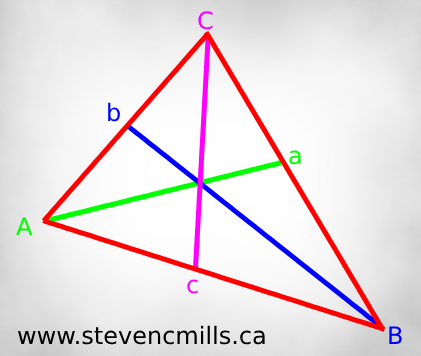01.23.2019: One Lesson of Math - The Sine Law, Part 1
- Steven C. Mills

- Jan 23, 2019
- 2 min read

Today's soundtrack is Darkthrone: Goatlord, a unique release from the black metal band of one of their rehearsal tapes from back when they did death metal, with black metal/operatic vocals added after the fact. It has a very raw, dark atmosphere.
This afternoon, I'm learning about the Sine Law.

When labeling a triangle that is not a right triangle, we will label the three angles as A, B, and C. The sides opposite from the angles are respectively labeled a, b, and c.
The sine law tells us that "a / sin A = b / sin B = c / sin C and sin A / a = sin B / b = sin C / c" (Pearson's Pre-Calculus 11, p. 471). We use the former for finding sides, and we use the latter for finding angles. The sine law applies to angles both obtuse and acute, and can be used for any triangle - not just right triangles! As long as we at least know either "the measures of two angles and the length of one side" (p. 472) or "the lengths of two sides and the measure of a non-contained angle" (p. 473), we will be able to solve any triangle using the sine law.
When asked to determine the number of possible triangles when given two angles and the length of one side, we need to find out whether there are 0, 1, or 2 possible triangles (citation). I found this helpful explanation on www.socratic.org (click the image to go to their site):
There are three things that we will be asked to use the sine law to do:
Find the length of a side
Find the measure of an angle
Solve a triangle
Let's walk through the steps for each of the three uses of the sine law.
How to use the sine law to find the length of one side when we know two angles and one side
Write out the sine law with the sides in the numerator positions
Using substitution, insert known values into the sine law equation
Using the Triangle Sum Theorem (A+B+C=180°), find the measure of the unknown angle
Using one of the fractions where both numerator and denominator are known, solve for the unknown side(s)
How to use the sine law to find the measure of a contained angle when we know two sides and one non-contained angle
Write the sine law with the angles (e.g. sin B) in the numerator positions
Using substitution, insert known values into the sine law equation
Using algebra, put together the fraction that is missing the numerator with the fraction where both numerator and denominator are known to find a second angle
Using the Triangle Sum Theorem, find the value of the contained angle
That's all the time I have for today. Next time, I'll work on solving a triangle with the sine law, and I'm going to try to get a better grasp on the concept of total possible triangles. I'll do my best to get some examples posted, too!





Comments